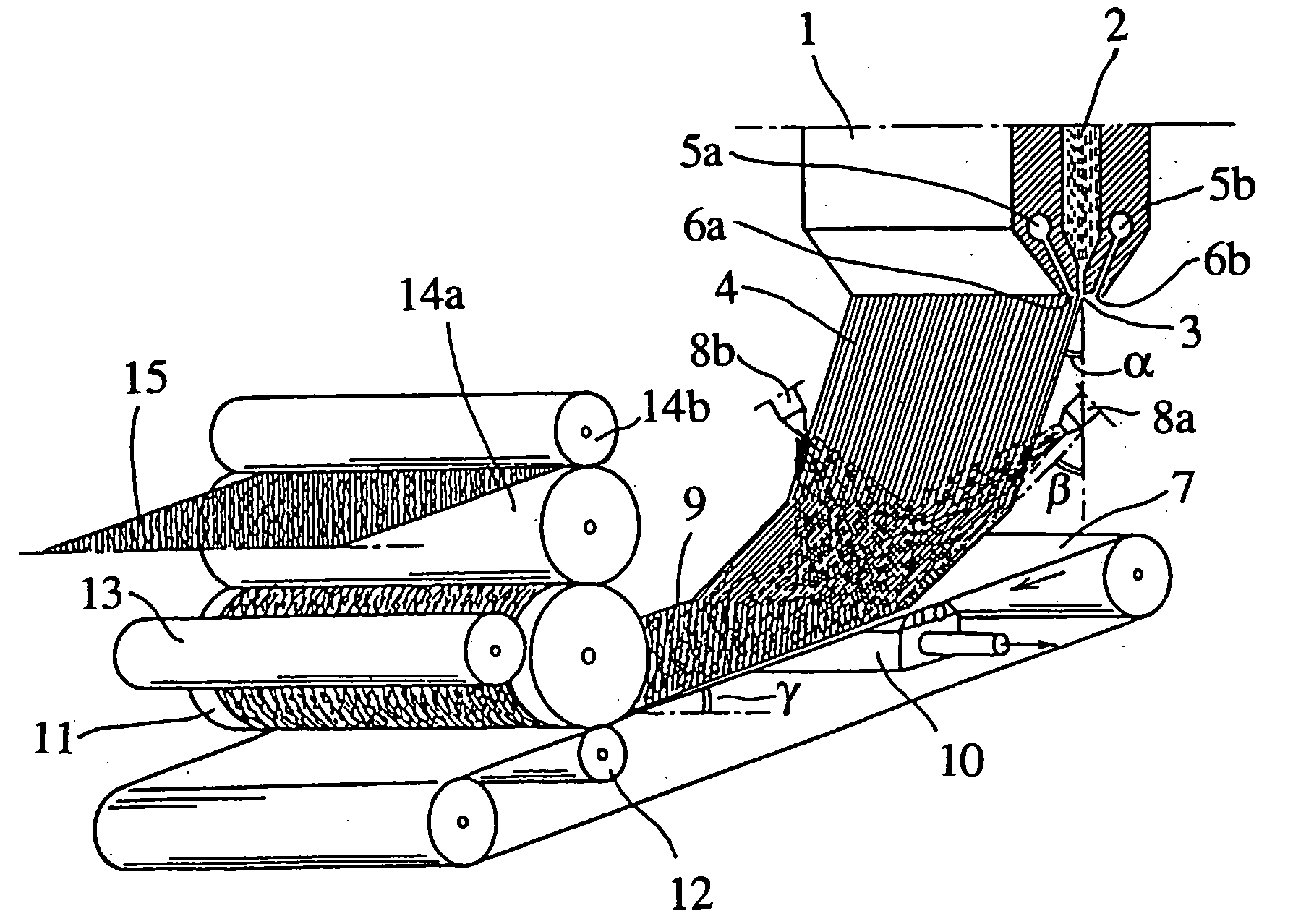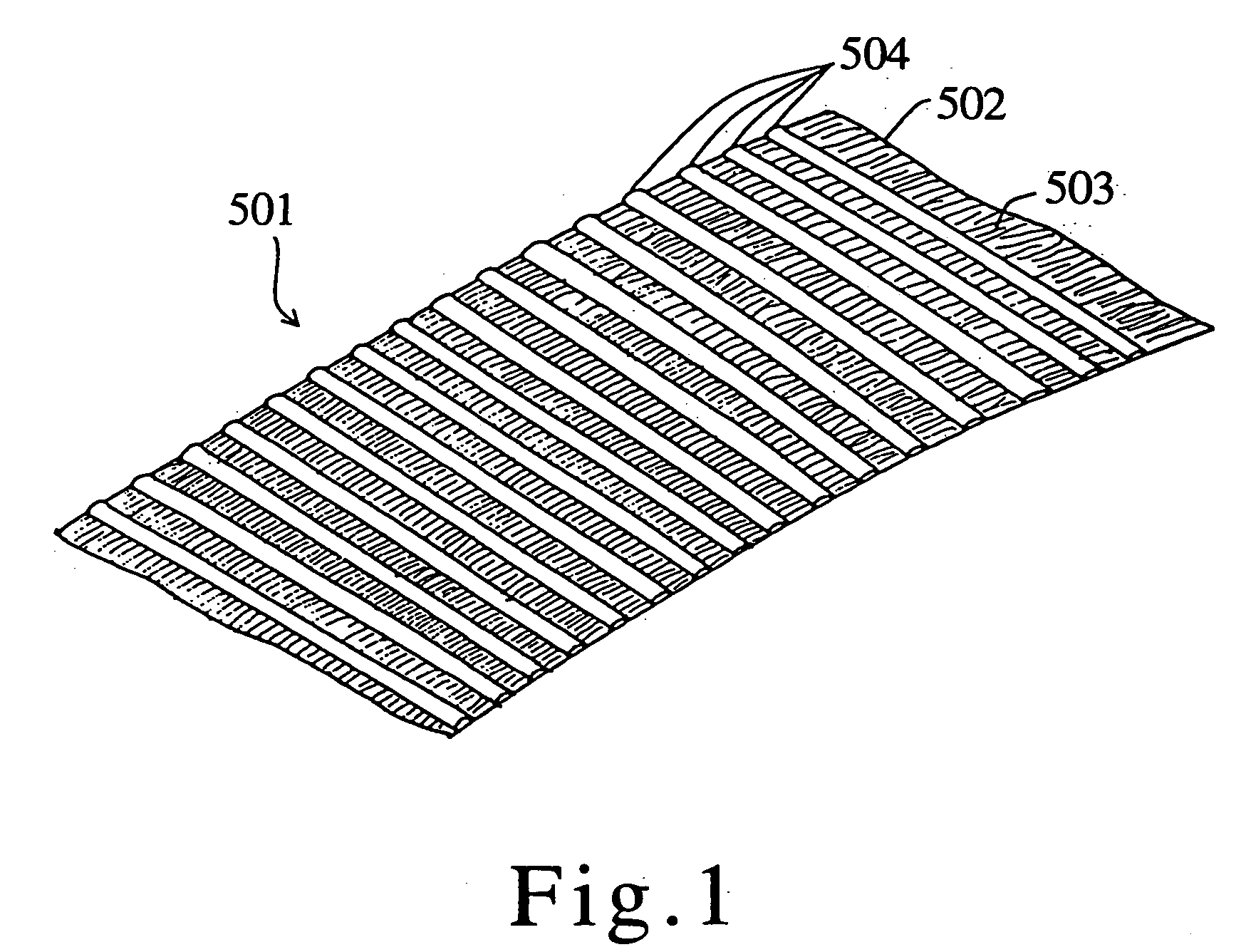Composite sheet having elasticity, elastic web made from thermoplastic elastomer, and method and apparatus of manufacturing the same
a technology of thermoplastic elastomer and composite sheet, which is applied in the field of elastic composite sheet, can solve the problems of unfavorable elastic-material elasticity, difficult to manufacture a composite sheet at low cost with the conventional method, and difficult to control the winding and spreading tension
- Summary
- Abstract
- Description
- Claims
- Application Information
AI Technical Summary
Benefits of technology
Problems solved by technology
Method used
Image
Examples
example 1-2
[0368] An elastomer web having orientation in the transverse direction manufactured using the apparatus shown in FIG. 9a to FIG. 9c was bonded onto a longitudinally stretched nonwoven fabric manufactured similarly to the example 1-1 using the apparatus shown in FIG. 13 to manufacture a composite sheet. The elastomer similar to that in the example 1-1 was used.
[0369] The resulting composite sheet was characterized by elongation of 10% in the longitudinal direction and elongation of 200% in the transverse direction.
example 1-3
[0370] A spun-bonded nonwoven fabric (amount per square meter of 80 g / m.sup.2) available on the market was stretched by a factor of 2.5 in horizontally direction at hot air temperature of 120.degree. C., using stretching apparatus shown in FIG. 11, whereby a horizontally stretched nonwoven fabric of which amount per square meter of 38 g / m.sup.2 was manufactured. The resulting nonwoven fabric had a strength of 1.7 g / tex in the vertical direction, elongation of 108% in the vertical direction, a strength of 13.5 g / tex in the horizontal direction, elongation of 22% in the horizontal direction.
[0371] Next, as shown in FIGS. 41a and 41b, while feeding the horizontally stretched nonwoven fabric 801, thermoplastic elastomer 803 was pushed out from a large number of filament dies 802 arranged 5 mm pitch in width direction. The strands of the vertical direction were formed on the nonwoven fabric 801 by the thermoplastic elastomer 803. SEBS (styrene--ethylene butylene--styrene) base polymer (K...
example 1-4
[0373] First, a polyethylene terephthalate resin (IV value 0.62) was used to provide a nonwoven fabric stretched longitudinally by a factor of 5.2 (basis weight 15 g / m.sup.2) with the scheme described in Japanese Patent Application No.10-34242. The nonwoven fabric had a strength of 1.6 g / d in the longitudinal direction, elongation of 14% in the longitudinal direction, and a strength of 0.04 g / d in the transverse direction, elongation of 185% in the transverse direction. The strength and elongation of the nonwoven fabric were measured in compliance with JIS L1906 (Test methods for non-woven fabric made of filament yarn), and the strength was represented with conversion to denier so as to adapt to various basis weights.
[0374] Next, the longitudinally stretched nonwoven fabric was supplied to the apparatus shown in FIG. 37, and liquid 409 for patterning was applied to the nonwoven fabric with transfer roller 403. The pattern of liquid 409 for patterning to be attached to the nonwoven f...
PUM
| Property | Measurement | Unit |
|---|---|---|
| elongation | aaaaa | aaaaa |
| elongation | aaaaa | aaaaa |
| elongation | aaaaa | aaaaa |
Abstract
Description
Claims
Application Information
 Login to View More
Login to View More - R&D
- Intellectual Property
- Life Sciences
- Materials
- Tech Scout
- Unparalleled Data Quality
- Higher Quality Content
- 60% Fewer Hallucinations
Browse by: Latest US Patents, China's latest patents, Technical Efficacy Thesaurus, Application Domain, Technology Topic, Popular Technical Reports.
© 2025 PatSnap. All rights reserved.Legal|Privacy policy|Modern Slavery Act Transparency Statement|Sitemap|About US| Contact US: help@patsnap.com



